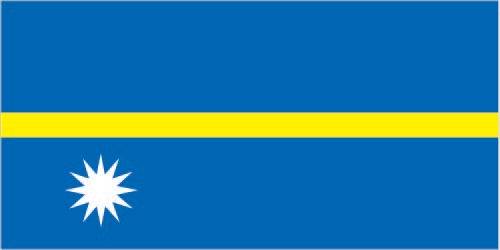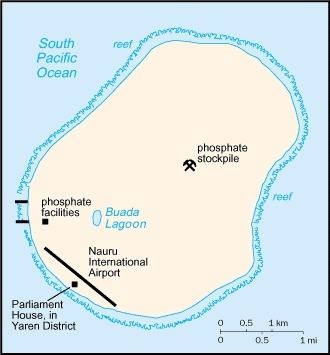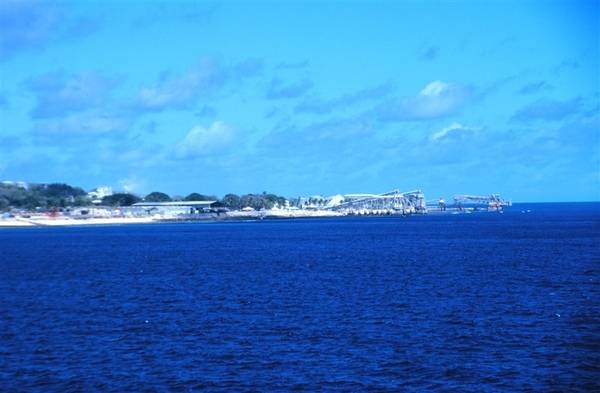42 Nauru

Blue with a narrow, horizontal, gold stripe across the center and a large white 12-pointed star below the stripe on the hoist side. Blue stands for the Pacific Ocean, the star indicates the country’s location in relation to the Equator (the gold stripe) and the 12 points symbolize the 12 original tribes of Nauru. The star’s white color represents phosphate, the basis of the island’s wealth.
Flag courtesy of the CIA World Factbook

Map courtesy of the CIA World Factbook

The phosphate ore loading piers on Nauru. Nauru has no natural or protected harbor. Phosphate mining was an important source of revenue for decades, but recent years have seen a significant decline production.
Photo courtesy of the CIA World Factbook
Government
According to Britannica, Nauru’s constitution, implemented with independence in 1968, calls for broadly phrased fundamental rights and freedoms for individuals and a government that combines parliamentary and presidential systems. The parliament, whose members are elected by Nauruan citizens age 20 and older, has a tenure of three years unless dissolved by a vote of no confidence. It elects the president, who is both head of state and head of government. The president appoints a cabinet from the parliament. In 1999 Nauru became a full member of both the Commonwealth and the United Nations.
The tripartite judicial system comprises a Supreme Court, a District Court, and a Family Court. The Supreme Court, presided over by a chief justice, has both original and appellate jurisdiction. At Nauru’s request, final appeals may be taken to the High Court of Australia.
Pacific Aviation Safety Office (PASO)
The Pacific Aviation Safety Office (PASO) is an international organization providing quality aviation safety and security service for Member States in the Pacific.
PASO is the sole international organization responsible for regional regulatory aviation safety oversight service for the 10 Pacific States who are signatories to the Pacific Islands Civil Aviation Safety and Security Treaty (PICASST).
The current PICASST signatories are the Pacific nations of Cook Islands, Kiribati, Nauru, Niue, Papua New Guinea, Samoa, Solomon Islands, Tonga, Tuvalu, and Vanuatu. Associate Members of PASO are Australia, Fiji and New Zealand. Government representatives from these nations make up the PASO Council.
Airspace
SkyVector – Google Maps – ADS-B Exchange
ICAO countries publish an Aeronautical Information Publication (AIP). This document is divided into three parts: General (GEN), En Route (ENR) and Aerodromes (AD). ENR 1.4 details the types of airspace classes they chose to adopt from classes A through G.
Drone Regulations
Republic of Nauru Online Legal Database
2021 Revision to Drones Act of 2018
Advanced Air Mobility (AAM) Regulations & Policies
Advanced Air Mobility (AAM) News
None found by the author.
However, should you, the reader, happen to stumble across something to the contrary, please email the author at FISHE5CA@erau.edu and you may be mentioned in the ACKNOWLEDGEMENTS section of this book by way of thanks for contributing to this free eBook!
Short Essay Questions
Scenario-Based Question
You have been hired by a Drone Startup Company. Your boss has immediately assigned this job to you.
They need you to prepare a one-page memo detailing the legalities of using a drone in Nauru.
They need you to mention any national laws and local ordinances.
They specifically want to know what airspace (insert pictures) you will be operating in and whether or not you need an airspace authorization.
Does it matter whether or not you are a citizen of the country?
Lastly, there is a bonus for you if, as you scroll through this chapter, you find any typos or broken links!
Short Essay Questions
- What are the drone categories?
- How is registration addressed?
- How is remote ID addressed?
- What are the model aircraft rules?
- What are the commercial drone rules?
- Are there waivers or exemptions to the rules? If so, for what?
- Would you share a link to an interactive airspace map?
- How is BVLOS addressed?
- How can you fly drones at night?
- How can you fly drones over people?
- Where do you find drone NOTAMs?
- What are the rules for drone maintenance?
- What are the rules for an SMS program?
- What are some unique rules not mentioned above?
- What are the C-UAS rules?
- What are the AAM rules?

